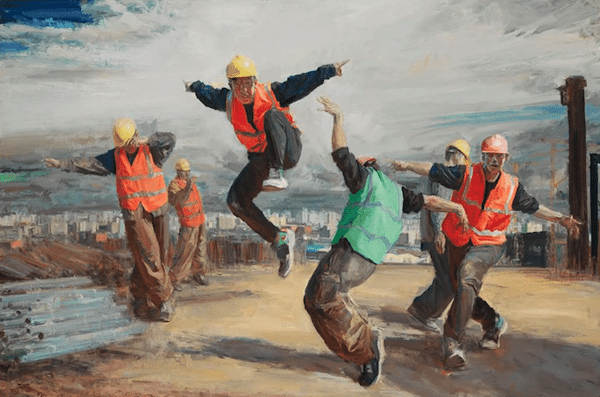Dear friends,
Greetings from Tricontinental: Institute for Social Research.
Late last year, a colleague sent me a letter decrying some of my writings about China, notably the last newsletter of 2023. This newsletter is my response to him.
**
The situation in China is the cause of a great deal of consternation amongst the left. I am glad you have raised the issue of Chinese socialism with me directly.
We are living in very dangerous times, as you know. The United States’ accelerating tension with other powerful nations threatens the planet more now than perhaps any period since 1991. The war in Ukraine and genocide in Gaza are illustrative of the dangers before us. In the interim, I worry about the U.S. trying to draw Iran into the conflict, with Israel threatening to escalate tensions with Hezbollah in Lebanon and then draw Tehran into making a step that would allow the U.S. to bomb Iran. The New Cold War against China will take these conflicts to another level. Taiwan is already the lever. I hope that sober minds will prevail.
All socialist projects, as you well know, are formed in the process of the class struggle and through the development of the productive forces. Not the least China. You recall Bill Hinton’s book The Great Reversal: The Privatisation of China, 1978—1989, published in 1990. I was with Bill in Concord, Massachusetts a year or so before he died in 2004 and had several discussions with him about China. No one in the U.S. knew China as well as Bill, his entire family (including his sister Joan and her husband Sid Engst, who modernised dairy farming in China), and of course their friends Isabel Crook, Edgar Snow, Helen Foster Snow, and, later, the translator Joan Pinkham, the daughter of Harry Dexter White.
In the 1990s and early 2000s, there was great trepidation about China. When I visited the country decades earlier, I was confounded by the poverty in rural areas. But at the same time, I was taken by the dignity of a people inspired by the great history of the struggles that created the Chinese Revolution of 1949 who knew that they were building a socialist project. Bill held fast to Maoism, clear about the contradictions of the socialist project, as he wrote in Through a Glass Darkly: U.S. Views of the Chinese Revolution.
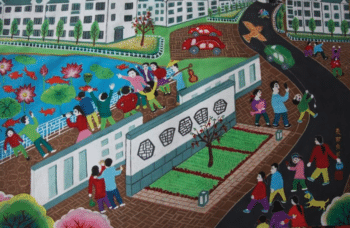
Sheyang Farmers Painting Institute (Jiangsu, China), part of the ‘farmers painting’ project, 2017.
Inequality had risen to high levels during the Jiang Zemin (1993—2003) and Hu Jintao (2003—2013) years. In Poorer Nations: A Possible History of the Global South (2013), I wrote about the Chinese Revolution with some of that pessimism, despite understanding the difficulties of building socialism in a poor country (the only place, after Russia, to try and do so since revolutions failed in the West). A few years after that, I read Ezra Vogel’s terrific assessment of Deng, Deng Xiaoping and the Transformation of China (2011), which placed Deng’s decisions in 1978 in the context of the entire revolutionary process. That book gave me a better understanding of the Deng reforms. One of the key lessons I took away was that Deng had to confront the stagnation of the economy, allowing the market to advance the productive forces. Without that, it was clear that China—a poor, backward country—would slip into a socialism of despair. It had to pioneer a new approach. Of course, the Deng reforms turned toward market forces and opened the door to a very dangerous situation. Bill’s pessimism was a response to that reality.
By the late 1990s, discussions began—including in the journals of the Communist Party of China (CPC)—to tackle rising rates of inequality and poverty through mass action. At the fifth plenum of the 16th CPC congress in October 2005, the party announced a ‘great historic mission’ to ‘construc[t] a new socialist countryside’, using the new phrase the ‘three rurals’ to refer to agriculture, farmers, and rural areas. This mission sought to improve rural infrastructure through state investment, provide free and compulsory education, and develop cooperative medical services while retreating from the market reforms in the medical sector, the latter of which became a nationwide policy across China from 2009. It interested me that the campaign was run with a mass character and not bureaucratically, with thousands of CPC cadre involved in carrying out this mission. This was a forerunner of the poverty eradication campaign that would come a decade later.
As this mission unfolded, I was very interested in the fact that places with ‘red resources’ were highlighted for action (such as Hailufeng in Guangdong Province, which was the heart of China’s first rural Soviet). It is telling that scholars in the West did not focus on these new shifts, fixated as they were on the country’s Pacific coastline rather than studying the conditions in China’s rural interior. Among the few exceptions are sincere people such as Professor Elizabeth Perry and Professor Minzi Su (the author of China’s Rural Development Policy: Exploring the ‘New Socialist Countryside’, 2009), who are ignored by most commentators on China.
This push for a new socialist countryside enlivened the CPC and a tacit movement to counter pure free-market forces, which created the dynamic that led to Xi Jinping’s election as party leader in late 2012. Xi’s concern for the country’s rural areas comes from spending part of his youth in China’s underdeveloped northwest and from his time as the party secretary of the Ningde Prefecture in the late 1980s, which was then one of the poorest regions in Fujian Province. A widely acknowledged element of Xi’s leadership during this period is that he helped decrease poverty in that area and improve social indicators, making youth less prone to migrate to cities.
Did China’s growth need to come at the expense of nature? In 2005, while in Huzhou (Zhejiang Province), Xi laid out the ‘Two Mountains’ theory, which suggested that economic and ecological development must go hand in hand. This is evidenced by the fact that, from 2013 to 2020, particulate pollution in China decreased by 39.6%, increasing average life expectancy by two years. In 2023, Xi announced a new ecological strategy to build a ‘beautiful China’, which includes an environmental plan for rural areas.
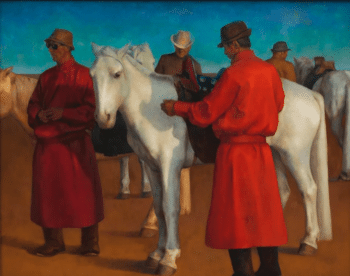
Zhang Hailong (China), Horses and Herdsmen Series 3, 2022.
I was struck by some of your claims, in particular that ‘forcible return to the countryside is now state policy’, which I think bears special reflection due to it being part of the broader ‘new socialist countryside’ policy. It is true that President Xi has been talking about the need for rural revitalisation since 2017, and it is also true that various provinces (for instance, Guangdong) have action plans for college graduates to go to the countryside and participate in making the rural as attractive as the urban. However, this is not done by force, but by innovative programmes.
At the frontlines of these programmes are youth, many of whom were among the three million cadres who went to villages as part of the policy to abolish extreme poverty (it is worth noting that 1,800 cadres died while carrying out this task). Xi is very sensitive, as Mao Zedong was, to the importance of party members experiencing the reality in rural China, given China’s vast rural landscape, and was himself sent to China’s rural northwest during the Cultural Revolution. Reflecting on this experience, Xi wrote in 2002: ‘At the age of 15, I came to Liangjiahe village perplexed and lost. At the age of 22, I left with a clear life goal and was filled with confidence’. There is something of this attitude in China’s policy. Is it bad for party members, many of whom might have jobs in the state apparatus, to spend time in the countryside? Not if you want them to better understand China’s reality.
I have been to China many times over the past ten years and have travelled extensively in both rural and urban areas. The dual circulation strategy that Xi has pursued (driven by this ‘new socialist countryside’ policy) is of interest, and I have been working with a range of scholars to build up a detailed, empirical understanding of the Chinese project from within and through their own categories. That is the basis of the work we have been doing, some of it published in Wenhua Zongheng and some of it in the Tricontinental: Institute for Social Research’s study on the eradication of extreme poverty in China. Is it propaganda? I hope not. I hope that we are getting closer and closer to being able to offer a theoretical assessment of the Chinese Revolution as it proceeds forward. Is the revolution perfect? Not at all. But it requires understanding rather than clichés, which abound in the West when it comes to China.

Abdurkerim Nasirdin (China), Young Painter, 1995.
Take, for instance, the allegations of the oppression of Chinese Muslims (25 million or 1.8% of the total population). I remember being in Central Asia in the 2000s when al-Qaeda and the Taliban had a serious impact on the region, including through the offices of the Islamic Movement of Uzbekistan (IMU). The IMU formulated a policy to take over the entire Xinjiang region, which is why some Uygurs moved to the leadership of Juma Namangani.
The Turkistan Islamic Party, led by people close to al-Qaeda (such as Abdul Haq al-Turkistani, who was a member of al-Qaeda’s shura), was born out of those sorts of contacts. Bombings of public places became commonplace, including in the Xinjiang Uygur Autonomous Region. Abdul Shakoor al-Turkistani, who in 2010 took over leadership from Abdul Haq (the engineer of the 2008 bombings in Beijing during the Olympics), was responsible for the Kashgar attacks in 2008 and 2011 and the Hotan attack in 2011. In 2013, this group moved to Syria, where I met a few of them on the Turkish-Syrian border. They are now based in Idlib and are a key part of the al-Qaeda formation there. This is their characteristic feature: not mere Turkic nationalism, but Islamic fundamentalism of the al-Qaeda variety.
At the time, several approaches could have been taken to the insurgency. The one that the U.S. and its allies in the region favoured was to use violence, including by attacking areas suspected of being run by these insurgents and arresting them en masse, with some of them ending up in U.S.-run black sites. Many of the members of this group, including Abdul Haq and Abdul Shakoor, were killed by U.S. drone strikes on the Afghanistan-Pakistan border. Interestingly, China did not follow this approach. Some years ago, I interviewed former members of the Libyan Islamic Fighting Group who had turned away from violence and the ideology of al-Qaeda. Their group, the controversial Quilliam Foundation (based in London), was led by people such as Noman Benotman who followed the approach of the Egyptian ‘repentance’ and the Algerian ‘reconciliation’ projects. These programmes essentially tried to adopt both cognitive and behavioural approaches to deradicalisation (changing the ideology and stopping the violence, respectively). The former Libyan jihadis were eager to bring this approach to play both in Libya (which failed) and in the West (where many of them resettled), rather than the alternative of targeted violence and mass arrests. They were rebuffed (except in Germany, where the Hayat Programme was established in 2012). The problem with the violent approach that the West opted for instead was that it demonised all Muslims rather than merely trying to deradicalise those drawn into a toxic politics.
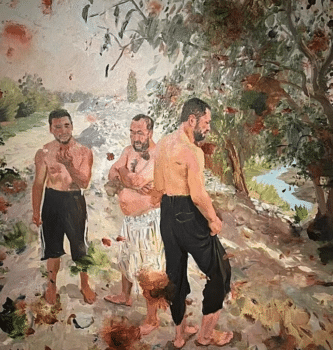
Liu Xiaodong (China), Belief, 2012.
In the case of China, rather than waging a frontal war against the radical groups in Xinjiang and then the society in which they lived and demonising all Muslims, the government sought to conduct forms of deradicalisation. It is useful to recall the meeting between the Chinese Islamic Association and the CPC in Beijing in 2019 that built on the Five-Year Planning Outline for Persisting in the Sinification of Islam and sought to make Islam compatible with socialism. This is an interesting project, although it suffers from a lack of clarity. Making Islam Chinese is one part of the project; the other is to make the practice of Islam consonant with the socialist project. The latter is a sensible sociological approach for the modern world: to make religion—in a broader sense—compatible with modern values, and, in the case of China, with ‘core socialist values’ (such as combatting gender discrimination).
The former is harder to understand, and I have not truly grasped it. When it comes to the idea that religion must be aligned with modern values, especially socialist values, I am fully on board. How should this happen? Does one, say, ban certain practices (such as headscarves in France), or should one begin a process of debate and discussion with the leaders of religious communities (who are often the most conservative)? What does one do when confronted by an insurgency that has its roots outside the country, such as in Afghanistan, Uzbekistan, and even Syria, rather than inside the country, such as the contradictions in Xinjiang? These are all pressing dilemmas, but the ludicrous statements about genocide and so on pushed by U.S. State Department and its cronies—including by dodgy people who work for dodgier ‘think tanks’ near the CIA’s headquarters in Langley, Virginia—cannot be allowed to define our discussion within the left. We need a greater understanding of the matters at hand so as not to fall into the Biden-Netanyahu line of questioning, which boils down to the ‘do you condemn Hamas’ sort of debate.
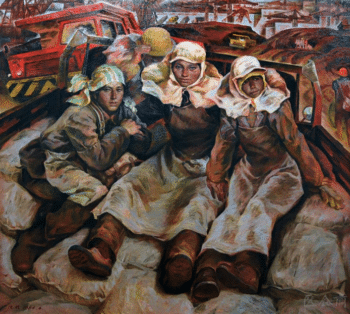
Tang Xiaohe and Cheng Li (China), Mother on the Construction Site, 1984.
In your email, you write that ‘there is no question that the living standards of ordinary Chinese people, especially city-dwellers, have improved dramatically over the last decades’. In fact, all the data—and my own travels—shows that this is not only the case ‘especially’ for city-dwellers but across the country and increasingly in the areas of the far west and far north. International Labour Organisation data, for instance, shows that China’s annual real wage growth was 4.7%, far and away above that of other countries in the Global South, and certainly higher than in India (1.3%) and the U.S. (0.3%) In just eight years, from 2013 to 2021, the disposable per capita income of China’s 498 million rural residents increased by more than 72.6% while that of the 914 million residents of urban areas increased by 53.5%. Meanwhile, the gap of disposable income between rural and urban areas declined by 5% during this period, and the growth rate of disposable income of rural residents has outpaced that of urban residents for twelve consecutive years (2009—2021).
Between 2012 and 2020, targeted poverty alleviation lifted 98.99 million people in rural areas out of extreme poverty and enabled every single family suffering from extreme poverty to receive assistance. As part of this innovative process, the CPC combined the training and development of grassroots cadres with digital technology, thus enhancing modern governance capabilities at the local level and enabling party members and cadres to serve the people more accurately and efficiently.
For comparison, using the Gini index, which does not cover public services (ignoring items like subsidised rentals for rural homes), income inequality in India is 24% higher than in China.
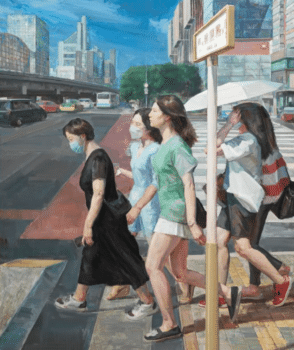
Wang Zihua (China), When the Wind Blows Through the Summer, 2022.
Those who look at the data on inequality in China often focus on China’s billionaires. That was clear in your email, which noted that China ‘is awash with state-subsidised millionaires and even billionaires. Indeed, a mounting class of super-bourgeoise, many of whom “invest abroad”’. Certainly, the reform era produced the social conditions for some people to get rich. However, that number is in decline: in 2023, of the 2,640 billionaires in the world, about 562 were in China, down from 607 in the previous year, and the last few CPC congresses have made it a priority to reverse the engine of this billionaire-production process. Of the 2,296 delegates to the 20th National Congress, only 18 were private sector executives, most of whom are from small and medium-sized enterprises, down from 34 who participated in 18th National Congress in 2012.
As you might know, in 2021 Xi called for a policy of ‘common prosperity’ (a term first used by the CPC in 1953), which alarmed many of these billionaires. They have since sought to run for the hills (‘invest abroad’, as you say). However, China has very strong capital controls, allowing only $50,000 to be remitted overseas. A range of illegal operations have opened up in the past few years to assist the rich in exiting their cash, including through the more porous region of Hong Kong. But the state has been cracking down on this, as it has cracked down on corruption. In August 2023, the police arrested the leaders of an immigration firm in Shanghai that facilitated illegal foreign exchange transfers. The pressure on Jack Ma (fintech company Ant Group), Hui Ka Yan (property developer Evergrande), and Bao Fan (investment bank Renaissance Holdings) is indicative of the CPC’s current position regarding billionaires.
You write that while living standards have improved in China, ‘socialism is not on the agenda in that country’. If not for the socialist agenda pursued by the CPC, how has China been able to abolish extreme poverty and bring down inequality rates, especially in times of rising global inequality when the social democratic agenda in the capitalist Global North and in large parts of the Global South has failed to come anywhere close to these achievements? It helps that large banks in China are under the control of the state so that large-scale capital can be managed efficiently to solve social problems, as we saw during the COVID-19 pandemic. The class struggle continues in China, of course, and that class struggle impacts the CPC (with its extraordinary membership of 98 million).
I have tried not only to provide some facts to guide our discussion but also to thread them into the theory of socialism that I believe is most attractive. According to that theory, socialism is not an event but a process, and this process—rooted in the class struggle—goes in zigs and zags, a back-and-forth tension that is often accentuated by the urgent need to increase the productive forces in poor countries. It is important to accompany such processes rather than taking an omniscient standpoint.
Warmly,
Vijay

